Samsung Q80T
Product Name: Samsung Q80T
Product Description: 2020 4K QLED TV
-
Design - 9.2/10
9.2/10
-
Video Quality - 9.1/10
9.1/10
-
Ports & Connectivity - 9/10
9/10
-
OS, Apps and Features - 9.5/10
9.5/10
-
Price / Quality - 9.2/10
9.2/10
Summary
Total Score
Pros
- Amazing image quality
- Support for HDMI 2.1
- Tizen smart TV platform
- Good price for what is offered
Cons
- Blooming due to low number of dimming zones
- Average contrast ratio
- No Dolby Vision
- No One Connect Box
Cheapest Places to Buy :
*We are a reader-supported website. When you buy through links on our site, we may earn a small affiliate commission at no extra cost to you. Home Media Entertainment does not accept money for reviews.*
Samsung could not create a bigger confusion with their models naming in 2020. You see, with the arrival of more 8K sets this year this meant that they had to scale the performance of all their models accordingly in order to incorporate these new TVs into their entire lineup. And as such the TVs we got this year is not exactly upgrades of last year’s models. In our Samsung Q80T review today we will be looking at another unit that belongs in Samsung’s premium 4K QLED lineup. Being second only to the top flagship Q90T, or third if you want to count the European only Q95T also, the Q80T is considered a middle tier unit in Samsung’s premium 4K QLED series and sits just above the Q70T that we recently reviewed.
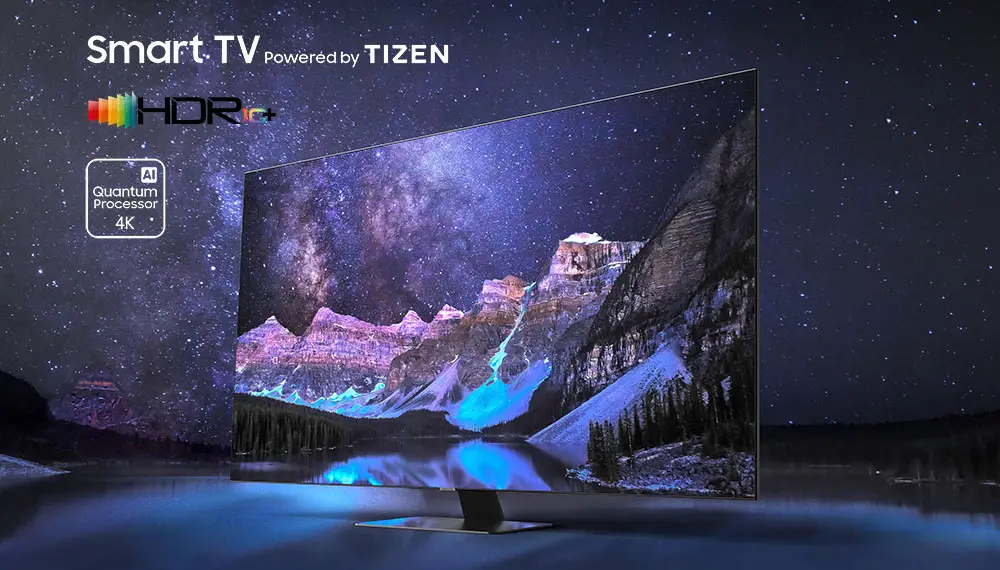
But here is where the confusion starts. Many will think that this is a direct continuation of the 2019 Q80R but with the performance swift we would say this one comes closer to the 2019 Q70R instead so most comparisons would have to be done with that model. Samsung created more confusion than was needed really but that’s why we are here to clear everything up.
But the Q80T has a lot going for it and we find a couple of major differences compared to the lower Q70T. First of all it’s the most affordable QLED with a Full Array with Local Dimming (FALD) backlight system. Anything below the Q80T uses an Edge LED, or Dual LED as Samsung likes to call it, light system so if you are in the market for a FALD TV then this is the most cost friendly offering by Samsung. The second major difference with the lower tier models is that the Q80T uses a newly designed audio system called Object Tracking Sound which we will analyze in the appropriate section.
Everything else seems to be the standard as the Q80T uses a VA panel as per usual, it has Samsung’s Quantum Dot technology for better and more vibrant colors, it comes with Quantum Processor 4K that offers AI image and audio enhancements and features the latest version of Tizen smart TV platform with all its functionality and online features. Oh, and we should not forget to mention the inclusion of HDMI 2.1 which was a bit surprising considering that Samsung had initially announced that only their 8K TVs would get it. So with all it has to offer, does the Q80T manages to be a competitive model in it’s category and what you should expect from Samsung’s most budget friendly FALD TV set? Keep reading to find out.
Design
If you expect to find the amazing One Connect Box you will be disappointed to know that Samsung decided to use this only for two models in 2020. Their top 8K flagship Q950TS and the European only top 4K QLED, the Q95T. It’s amazing that in the US Samsung doesn’t have a single 4K TV that uses the One Connect Box and it feels like they try to phase it out slowly rather than use it in more of their models as we were hoping a few years ago when they started using it.
As for it’s general looks and design the Q80T is a really nice TV featuring a boundless design in all four sides which gives a more premium feel to it with very thin borders giving the image a more pronounced look. The TV’s overall thickness is very good although slightly thicker than the Q70T as it has the FALD system at the back which adds a bit of depth. But overall it is a very thin TV for being a FLAD one and will definitely look nice if you plan to wall mount it.
The back side features a similar design to the one we saw in the Q70T with a dotted design covering most of it’s surface. All ports are grouped together on the left side on a special inset with sideways orientation that can definitely help with cable management if you want to place in on a wall. On the right side we only find the power connector while on the bottom we get special grooves in order to drive the cables to the central stand. Lastly we get holes for the VESA wall mount.
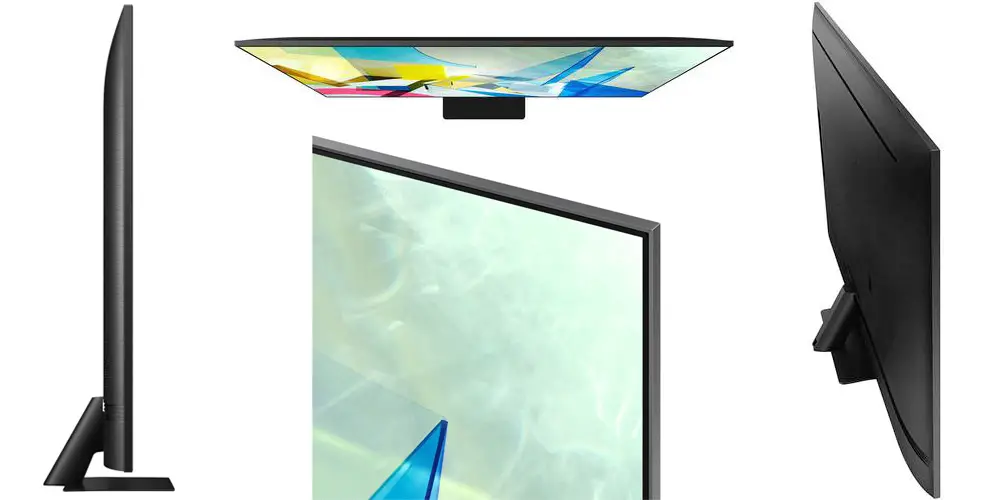
Let’s talk a bit about the stand as the Q80T uses a pedestal-style stand which looks pretty nice and is small enough so you can place the TV even on small furniture. Obviously this kind of stand can cause the TV to wobble a little but is stable enough not to cause any trouble. The stand is using both plastic and metal and with it’s flat surface makes installation of a soundbar far easier than some other stands we have seen from Samsung recently. The back of the stand is hollow so you can pass the cables through it for a cleaner look.
The remote that comes with the Q80T is exactly the same we saw in both the Q70T and Q60T and is the usual One Remote with the standard gun-metal black arch back design. As we had mentioned in our previous reviews the design is exactly the same as last year with the only change being the Hulu dedicated button being replaced with Samsung TV plus.
Everything else is completely the same with the One Remote coming with a built-in microphone that you can use to issue commands to the various voice platforms the TV has built-in. If your other devices have HDMI-CEC then the remote can act as a universal remote also but Samsung took this one step further as it can also control other devices even without having the required HDMI-CEC functionality. We were always fond of Samsung’s approach to their remotes and the One Remote shows that they are happy with the design they have and in all honesty so are we. It’s obvious that they rely more on the TV’s UI instead of fighting with the remote’s buttons and we believe this is the way to go.

In total we can say that the Q80T does feel like a premium model. Very nice four sides boundless design, great central stand and good materials used along with a remote that is at the top spots of our favorite remotes the last few years makes this an overall great looking TV.
Video Quality
Processor technology used
The Q80T comes with the same Quantum Processor 4K that we had previously seen in the Q70T and the other QLEDs with the exception of the Q60T that uses a “light” version of this chip. This means that the Q80T features the same AI enhanced capabilities as far as it’s image and audio is concerned. These include a specialized AI upscaling engine that is combining complex algorithms and a huge image database in order to classify aspects like textures and edges, and to optimally upscale each specific scene.
As we always do for this part of our review we tried different resolutions of content from old SD to higher resolution 720p and 1080p Full HD content and the TV did a remarkable job at upscaling everything to 4K with no additional artifacts. But obviously the best quality the content is the better the upscaling, as old SD content will not fair very well in a big TV nowadays anyway.
With such an advanced processor this TV also comes with Adaptive Picture which is a feature that analyzes the light conditions in your room and can calibrate the picture accordingly in order to provide you the best image quality for your specific situation.
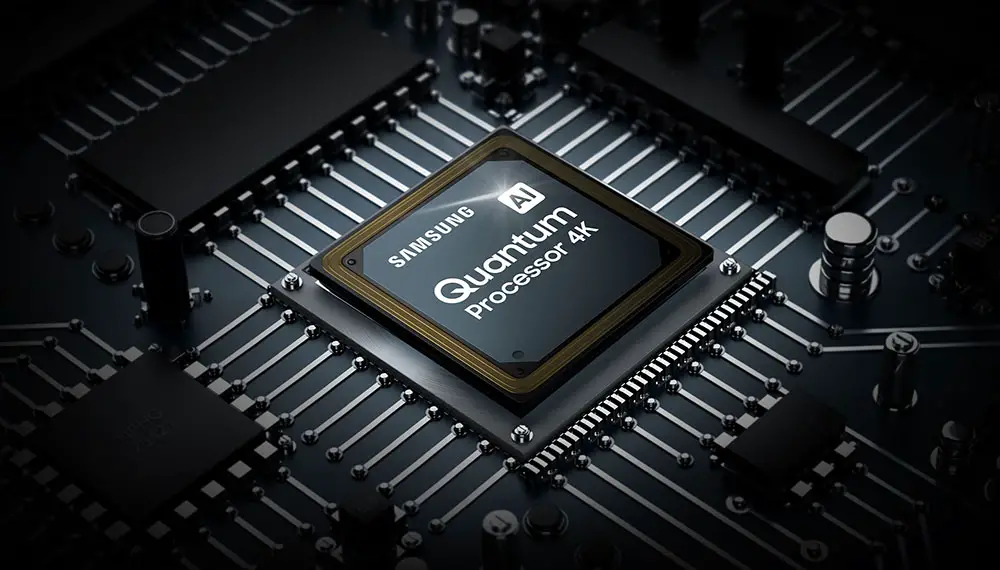
But the Quantum Processor 4K does not only bring image processing to the table but also includes a few audio enhancements including Adaptive Sound and Spatial Analysis along with Active Voice Amplifier (AVA). More on these technologies in our audio section.
Lighting technology used
If there is one characteristic that can drastically change the image quality of these QLEDs is the type of backlight system they use. For 2020 it seems that Samsung have used the better Full Array with Local Dimming (FALD) backlight system in their Q90T and Q80T models while the Q70T and Q60T had to settle for the inferior Dual LED system.
A FALD system in order to perform good depends on two factors, the number of dimming zones available and how fast each zone can change it’s light output. The more dimming zones used the better and more accurate light control the TV has but also the higher the price goes, that’s why they usually scale the dimming zones number depending on the model. The effect on having low number of dimming zones can be seen when you see a very bright object on a completely dark background. If the TV has very few zones light will escape to the nearby pixels and create a visible halo around the object.
Also the light algorithms play a huge role as they control the response time of the various dimming zones. If the change is slower than it should be you will see what is called ghosting when a bright object moves very fast against a dark background.

As for the Q80T specifically we measured five rows with ten columns totaling 50 dimming zones which is similar to what we saw in last year’s Q70R. With 50 zones available the end result may not be as good or accurate as we would like but in all honesty is far better than any Edge LED system can do and we would take even the most basic FALD any day. Obviously Samsung had to keep the cost relatively low for the Q80T so they used as few zones as possible and spend more time refining their algorithms to perform better. The result may not be the most ideal but if you compare it with the Q70T things are far better here in comparison.
If there is one minus in having a FALD system in the TV is that usually this adds slightly to the thickness of the unit as the FALD system is incorporated at the back of the panel. The difference is not very big and the Q80T still looks very good so you shouldn’t worry too much about this.
The Q80T is the most affordable FALD TV Samsung is offering in 2020 so if you are looking for such a unit then the Q80T is the one you should look at.
Brightness / Contrast
Let’s see now how the TV fairs in it’s brightness tests. As always we used the more accurate Movie mode with max brightness and high Local Dimming settings and in our SDR brightness over a 10% window we got a measurement of 702 nits which was excellent and more than you will ever need for SDR content. On the HDR brightness the 10% window gave us a measurement of 730 nits which is very good and can create some pretty impressive highlights.
The Q80T really managed to offer much better performance than what we saw in the Q70T. The FALD system seems to help with this also and in general the Q80T could pump enough brightness to make HDR justice and show how it is really meant to be seen. From these measurements we also got confirmation that the Q80T performs in the same league as the 2019 Q70R but with obvious better performance in the SDR brightness. With HDR content we can say that both units are more or less equals.
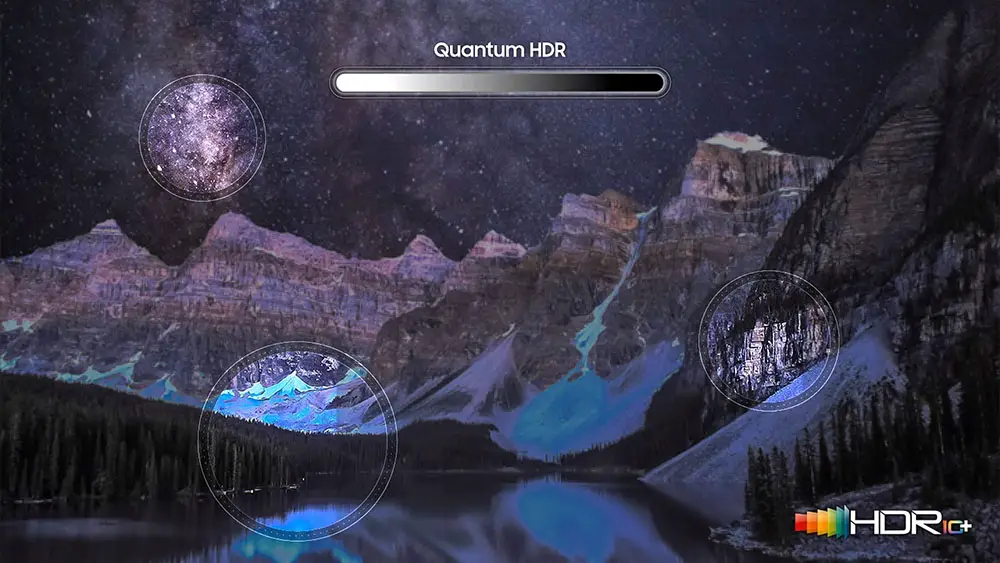
Now we should mention that for our testing we used a 55″ model. According to Samsung the 49″ size along with all the European models use Direct Full Array 8X instead of the Direct Full Array 12X we get here so this means that they probably use either a less capable FALD system or even less dimming zones and thus naturally perform worse than the measurements we got here. Keep this in mind when you do your comparisons.
As for it’s contrast the TV has good but not great. This is possibly a result of the Ultra Viewing Angle technology that is used in this one in order to improve the viewing angles that all VA panel equipped TVs suffer from. This has a side effect of reducing the contrast ratio a little. With the included Local Dimming feature black levels do improve but in general they still suffer from a slight grayish tone.
In general we can say that the Q80T is a huge improvement over the Q70T. The FALD system here makes a big difference while contrast ratio is good but not great. Performance of this TV is comparable to last year’s Q70R but with better brightness in SDR content.
Viewing angles
With viewing angles things are pretty obvious. This model along with the other Samsung TVs use a VA panel which offers very poor viewing angles. For this reason Samsung has used a special filter they call Ultra Viewing Angle in order to improve the end result. The Q80T managed to offer respectable image quality up to around 40 degrees from center position which is very good all things considered. Anything more and the image will start degrade very fast.

What this Ultra Viewing Angle technology does is to minimize the light leakage by focusing the light on the right direction and as a result we get wider viewing angles. A similar but less efficient technology called Wide Viewing Angle we saw in the Q70T. One thing we should note here is that the 49″ size does not have this special layer so viewing angles will be far worse while the European Q80T has to settle with the less efficient Wide Viewing Angle instead.
HDR support
No surprises here actually. The Q80T supports the same set of HDR protocols as with all other Samsung TVs this year meaning that we get the basic HDR10 that is used for 4K UHD playback, the more advanced HDR10+ that was developed by Samsung to rival Dolby Vision that uses dynamic metadata for more accurate and higher quality images and HLG that is used for broadcasting.
With no Dolby Vision Samsung TVs have a major disadvantage but as HDR10+ now starts to become more widely available it’s still very early to determine what will become of this silly and unnecessary HDR format war. But one thing is for sure that with Samsung firmly behind the HDR10+ bandwagon don’t expect to see Dolby Vision in their TVs any time soon.
Color coverage
The Q80T is using what is known as Quantum Dot technology that is used by all Samsung’s QLED models and is responsible for displaying better and more vibrant colors. This technology is basically a special layer that is used on the panel and with it’s nano-sized Quantum Dots, that are finely tuned particles, they turn light into the billion plus colors you see on screen.
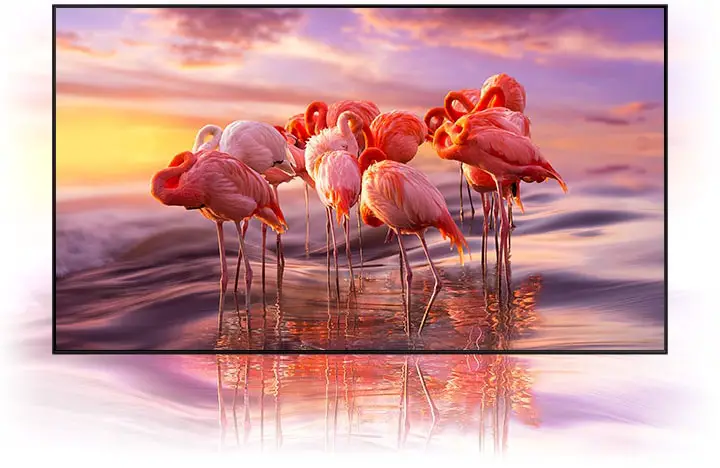
The Q80T managed to cover a 90% of the DCI-P3 color space which is great while on the wider REC.2020 it gave us a coverage that averaged at 70% which is also very good. These numbers indicate slightly better performance than the Q70T and similar to last year’s Q70R which is another strong indication that the Q80T should be more compared to the Q70R and not the Q80R from last year.
We are very pleased with the color coverage we got here as with the TV supporting Wide Color Gamut you will be able to get vibrant and lifelike colors as well as very good color gradients.
Motion performance
Let’s move on to our motion performance tests now. The Q80T comes with a 120Hz panel and with a backlight dimming frequency of 960Hz which basically seems to be the same as the Q70R. With such a high frequency flickering is not visible at all but obviously this depends on the picture mode that you choose as some of them will drop the frequency to 120Hz making some slight flickering visible.
Motion interpolation couldn’t be missing and the Q80T does a very good job at removing motion blur and judder. By enabling the Picture Clarity setting in the menu you can adjust the two available sliders for blur and judder according to your preferences. Too much of these and the “Soap Opera Effect” will show it’s ugly face but with very small settings you can get very nice and smooth results.
Black Frame Insertion (BFI) has become a standard lately and the Q80T also uses it by enabling the LED Clear Motion option setting. BFI is basically inserting a black frame in between two individual frames and this can result in smoother motion. But with BFI enabled flickering with further dive to 60Hz which can make flickering become very obvious while brightness is also lower due to the included black frames.
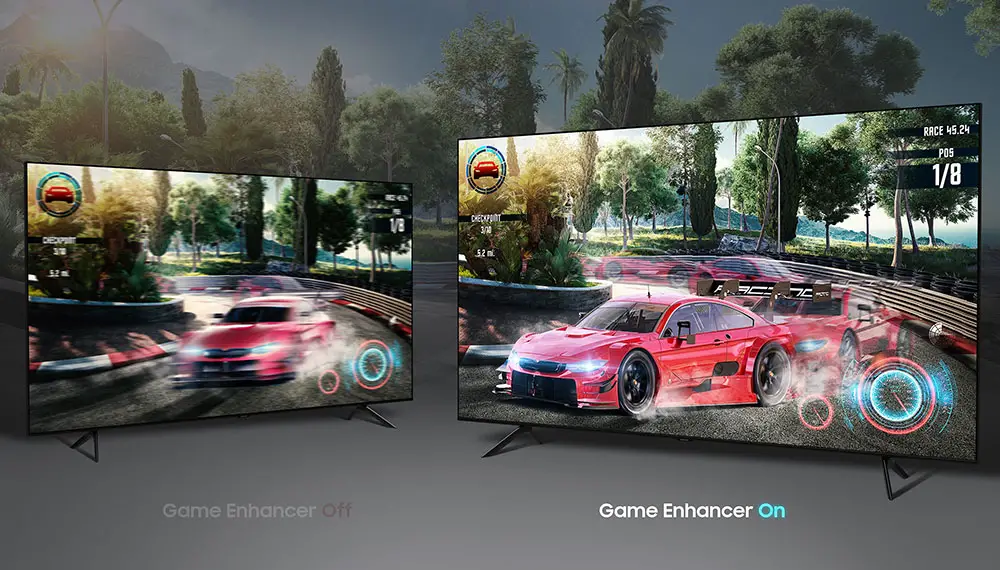
In general the Q80T did an excellent job with Motion Interpolation as there were very few artifacts visible and getting very good scores by us because of this. Lastly we should not forget to mention support for both FreeSync and HDMI Forum Variable Refresh RATE (VRR) which can work in case you connected another device that supports any of these two.
Input lag
We are used to get very low input lag measurements from Samsung lately so we had high hopes for the Q80T also. And we didn’t get disappointed as with Game mode enabled we got approximately 10.2ms of input lag which is amazing and can satisfy even the most serious of gamers. This is an average of both 4K and 1080p resolutions but the difference between the two is extremely small to be noticeable.
Without Game mode on, input lag went as high as 74.7ms so keep that in mind when using different Picture modes for different content. There is also Auto Low Latency Mode support (ALLM) and both PS4 and Xbox can benefit from it as both consoles support this feature.
For a real world testing we used F1 2019 through our PS4 and went on a few laps around in our Ferrari F1 to get a sense of response we would get from the TV. In one word, amazing. Every response, every reaction and every movement registered immediately on screen. There were no delays or lagging and we had a gaming session that was more smooth than ever. If you want a good quality TV but also like to have amazing gaming sessions the Q80T is one heck of a TV for it.
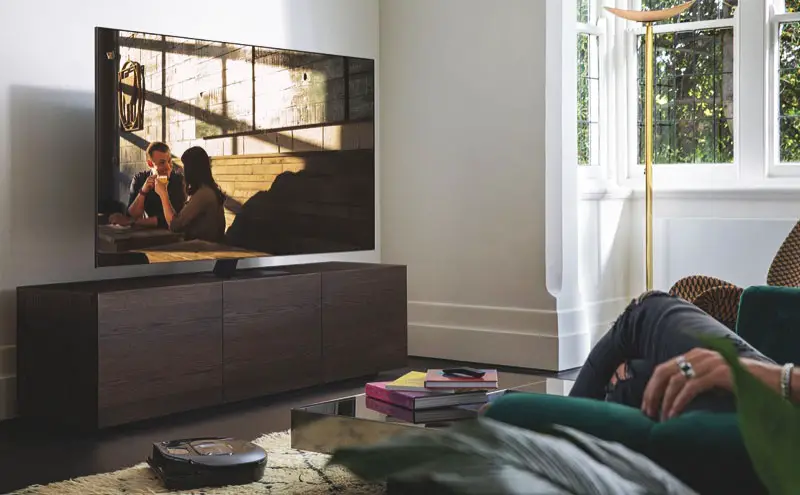
Image quality impressions
As we were expecting when we did our Q70T review, the Q80T here today gave us the kind of performance that very much resembled what we saw in last year’s Q70R. Both of them feature similar FALD systems with very close brightness measurements although the Q80T managed to fare much better in the SDR brightness. Also color reproduction and coverage was great while viewing angles were much better than the average VA panel due to the inclusion of the Ultra Viewing Angle technology.
Having the amazing Quantum Processor 4K means that we got amazing 4K images while the processor’s AI capabilities offered amazing upscaling along with other image and audio improvements. Lastly motion performance was very good and we got very smooth motion with very little visible artifacts overall.
The Q80T did manage to give us very good results overall and they were a very respectable upgrade from what we got in the Q70T. If you want to get good quality but you are also concerned about the price the Q80T provides the best balance between the two and we are sure that many will turn towards this model for their viewing pleasure.
Audio Quality
We had briefly mentioned that the Q80T is the first TV that utilizes Samsun’g newly developed Object Tracking Sound technology albeit in it’s most basic form compared to the one we get in the Q90T along with the 8K TV sets.
Samsung describes this as a 2.2.2 channels system and what this really means is that in addition to the traditional two down-firing drivers along with the two woofers we get two additional channels that have been placed at the top two corners of the TV. And this is from where this 2.2.2 channels stems from which is capable of producing 60 watts of power in total.
Now with more speakers available sound not only feels more dynamic and more punchy but also provides a bit more immersion to the image. Don’t expect to get any kind of Dolby Atmos performance as everything is still firmly at the from but with Object Tracking Sound, depending on what you see on screen the top two woofers act accordingly and give you a better overall acoustic soundstage. We can say that the result is very obvious when you compare it with a normal 2.0 system that many flat TVs have but on the other hand don’t expect any miracles. But we can definitely call it a step to the right direction.

But the Q80T is not limited to just the Object Sound Tracking technology as there are a few other additional audio features available. One of them is called Adaptive Sound+ and with this the TV can analyze each scene in order to identify and render the best sound type. The process begins by separating and classifying audio input signals. Key characteristics are then pulled out and rendered to best suit the scene.
We also get what is called Spatial Analysis. Every environment is different and can offer different sound acoustics so the Q80T can send out and collect inaudible signals in order to analyze your area and deliver optimized audio. Included in this is the Active Voice Amplifier (AVA) that analyzes the ambient noise and enhances the voices so you can get more clear dialogue in case of background noise that can make voice harder to discern.
Closing we can honestly say that the Object Tracking Sound system in the Q80T left us with very positive impressions. It did manage to offer more punchy sound with some clever positional audio but in no way it can replace even the most basic of dedicated audio systems. We would describe it as a step above the more common 2.0 channel systems but still one step below what most soundbars can offer nowadays.
Ports and Connectivity
When it comes to it’s connectivity options the Q80T utilizes exactly the same ports layout we saw in the Q70T also. As mentioned before all ports are located on the left side of the back panel, placed inside a special inset that can help with wall mounting as all of them face sideways and only the power connector is placed on the right side.
From top to bottom we get two USB ports, a digital optical audio output, four HDMI ports, an Ethernet port for wired connection to the internet, an Ex-Link mini jack along with the usual antenna port or ports depending on which country you get it.
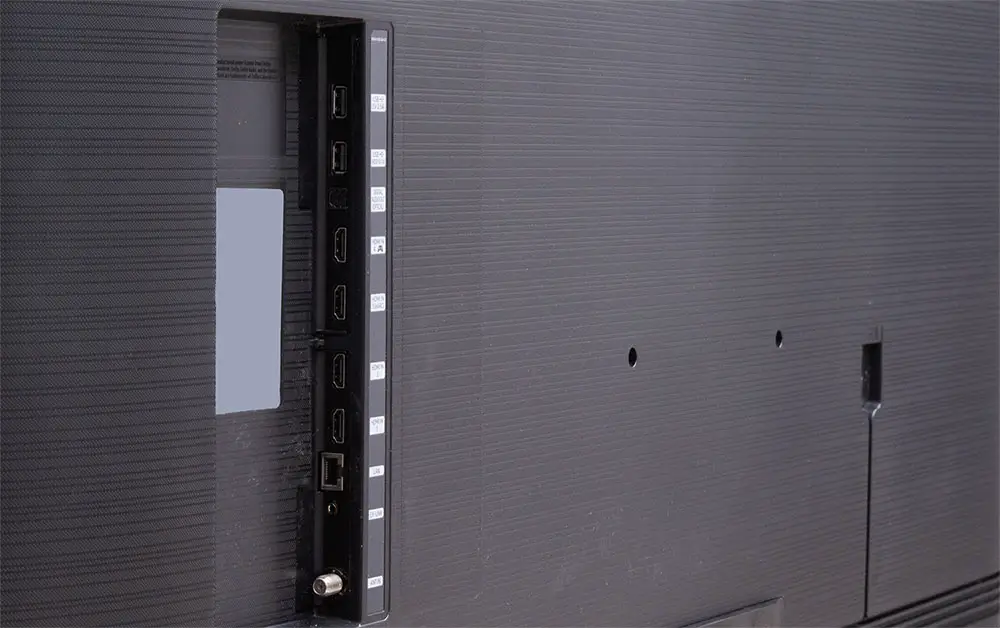
As we said in our Q70T the single most important feature here is the inclusion of the HDMI 2.1 in position 4 and all the new features that this new port brings with it. It’s good to see that Samsung decided to include HDMI 2.1 in their 4K QLEDs also (except for the Q60T) because their main rival LG is already utilizing these ports into their models and thus would make Samsung being left behind in this race. But except from HDMI 2.1 we also get eARC in HDMI 3 which many new devices start to use so it’s good to have it included in this TV also. On another note the USB ports are the older 2.0 instead of the faster 3.0 and this is a minus in our books.
As far as wireless connectivity the Q80T comes with built-in WiFi (802.11ac) along with Bluetooth v4.2 for wireless streaming from other mobile devices.
OS, Apps and Features
The Q80T comes with the 2020 version of Samsung’s Tizen and things here are pretty much the same as we saw in the Q70T and Q60T so this part of our review will be almost the same as in the other models. In 2020 Samsung made a few changes to their smart TV platform but nothing major as you could say most of these are basically improvements and small additions. The 2020 version comes with a dark UI which looks very different than the light white we were used in previous years. The change is mostly aesthetic so it’s a matter of taste if you like the new look or not.
General layout is the same as we get the launcher bar at the bottom of the screen along with a second row above it for making certain selections easier and faster including apps and additional content. And speaking of content with so much available, customization is a necessity and Tizen provides you with everything you need in order to re-arrange all icons in your own way. If you are using multiple services and apps you can place the ones you use the most at the beginning for easy access.
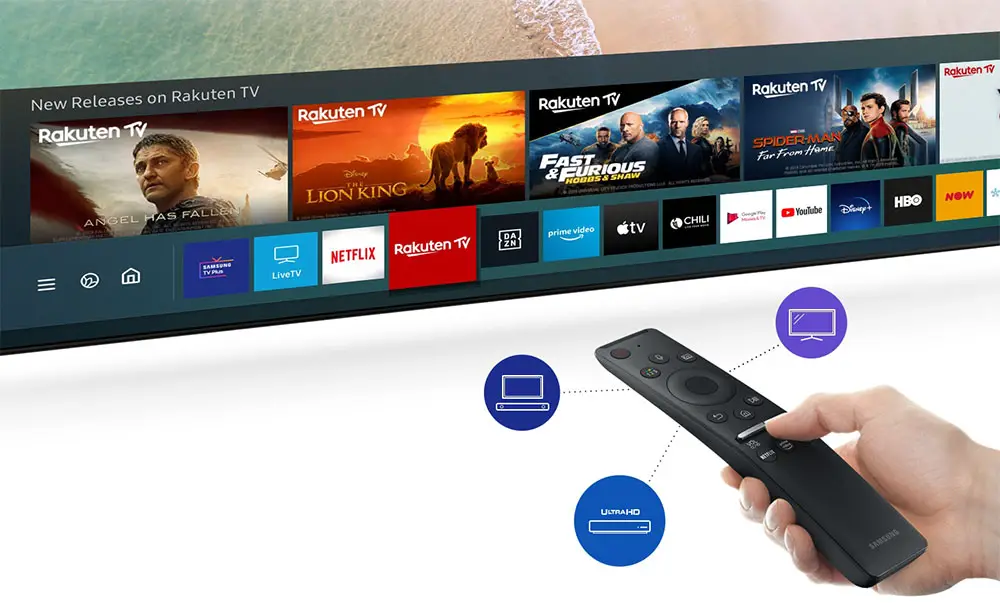
As for the streaming services included this wouldn’t be Tizen if there was no strong support for it. You can literally find everything you will ever want as all known names are included here. With Netflix, Apple TV, Disney Plus, Youtube, Amazon, Hulu, Rakuten, Demand 5 and BBC iPlayer being among the many more available you will certainly find the one you are looking for. As for Netflix and Amazon both of them support 4K and HDR. Navigation could not be any smoother as every command from the remote was registering immediately on screen without any visible delays or lagging.
Having so much content can be hard to handle especially if you are using many of these streaming services in general. For this reason Samsung has created the “Universal Guide” which is a very handy Tizen feature that is responsible for creating a ‘For You’ page that includes content you might be interested in watching based on your viewing habits. If you are are watching specific series for example the TV will analyze your viewing habits and give you suggestions which can be a real time saving feature.
There are also a few features that were included the last few years and one of them is SmartThings integration. With this you can use your TV to control other smart devices in your house like lights, door locks, thermostats and shades that also support SmartThings and make the Q80T your central smart hub of your house.
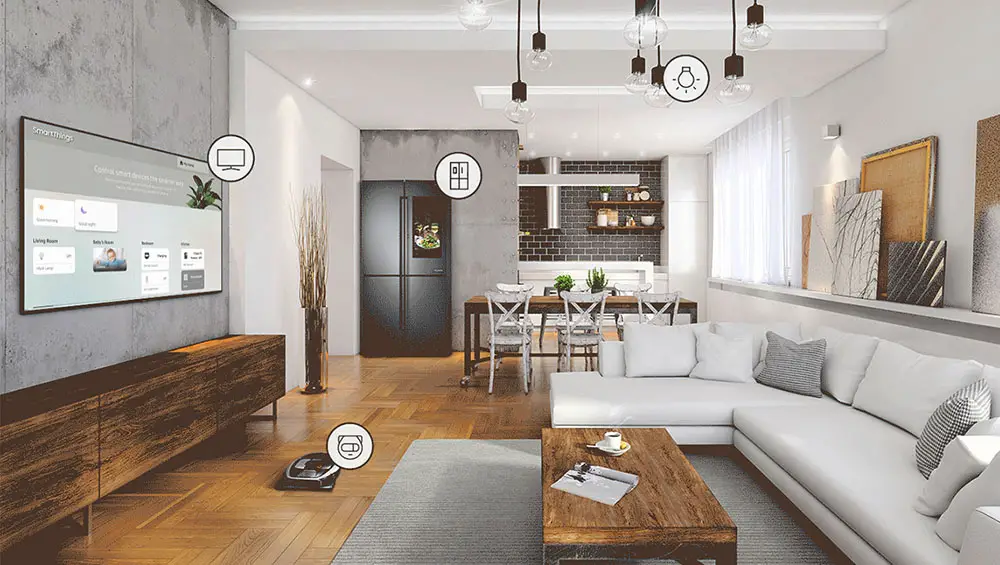
But for this to work on a TV you really need voice control functionality and the Q80T comes with support for all the most known ones. First of all there is Samsung’s Bixby but even if you don’t like Samsung’s offering you get support for both Amazon Alexa and Google Assistant. But voice control does not end there as with the TV’s support for Apple’s Airplay you can use Siri to issue your commands. Plenty of options to choose from in this regard.
One feature that has updated from last year is Multi-View. Basically the name is new but in a way this is an updated version of screen mirroring that we have in TVs for many years now. What this does is that now instead of simply mirroring your mobile device screen on the TV you can get a split screen where you can see both the TV and the mobile’s screen at the same time. Although it’s a nice gimmick to have we still haven’t found a practical way to use it but anyway, the more we get the better.
Last but not least we find the enhanced version of Ambient Mode now called Ambient Mode+. With this feature you can turn your TV from a black spot on your wall to a work of art as it can display various images and designs when you don’t use the TV in order to blend it to the environment. But with this improved version you can also display various other information including weather updates, news headlines, photos and music.
What can be said about Tizen that has not been said already. It’s an amazing platform and Samsung continues to add various, even small, improvements every year making it better and better. Some of these new features are not something major but anything new we get is always good to an already excellent smart TV platform.

Final Thoughts
The Q80T is an amazing model for it’s category and it really managed to offer us the kind of performance and features we were expecting. Make no mistake, this model should not be compared with last year’s Q80R as with more 8K TV sets this year Samsung had to shift the performance of these models to incorporate the new TVs and as such the Q80T should really be compared with 2019’s Q70R instead.
Now as for the TV’s most strong points we can say that the Q80T can produce amazing 4K images with excellent colors due to the Quantum Dot layer and very good brightness in both SDR and HDR content. The inclusion of a FALD system really helps to improve the overall image while the Ultra Viewing Angle technology give this TV far better angles than what we usually see in VA panel equipped TVs.
The inclusion of the Quantum Processor 4K offers AI capabilities in both the image and audio departments while input lag was measured crazy low making it ideal for any gamer. Motion performance was also way above average with good motion interpolation and very few visible artifacts. If you include in all this the excellent Tizen platform with all it’s features, the newly designed Object Tracking Sound audio system, the very nice design and the inclusion of the One Remote what we get is an amazing offering from Samsung in this class.
On the downsides now. The FALD system has very few dimming zones and this can create halos around bright objects when viewed against dark backgrounds. No Dolby Vision means that many will stay away from Samsung’s offerings since Dolby’s advanced HDR has the upper hand at this moment of writing. And lastly due to the included Ultra Viewing Angle contrast ratio is average and blacks look more gray than what we would like.
In total there is so much to like in this model. It seems like this TV managed to strike the perfect balance between quality and cost. The inclusion of a FALD system and the new audio system are obviously the big highlights here but there are so many things this TV has on offer that we could very well call the Samsung Q80T the perfect cost sensitive performance TV in Samsung’s arsenal at the moment. Highly recommended.
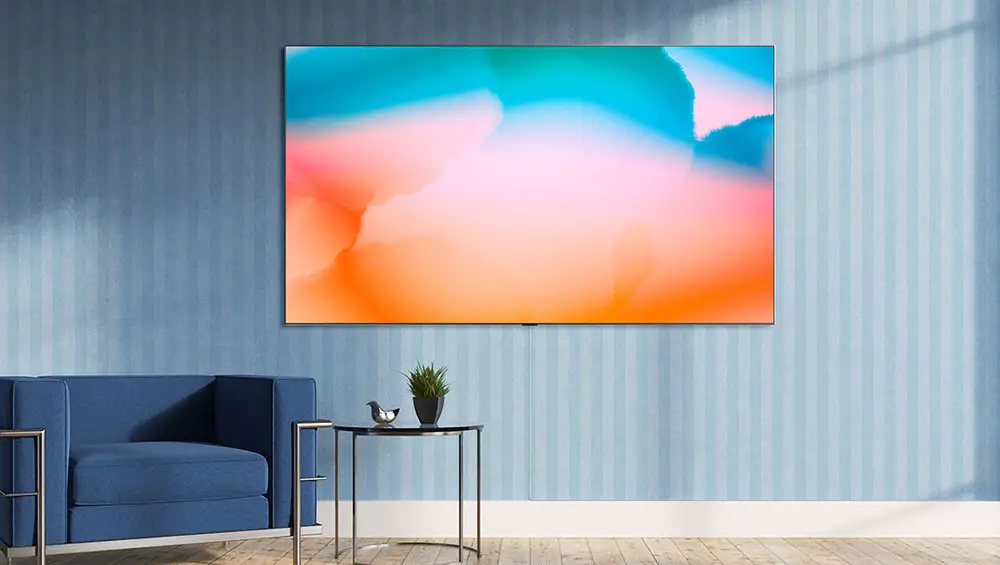
For more reviews you can check our dedicated 4K LED LCD TV reviews list or even look at our Product Reviews Table where you can find the brand and specific product you are looking for.
Cheapest Places to Buy :
*We are a reader-supported website. When you buy through links on our site, we may earn a small affiliate commission at no extra cost to you. Home Media Entertainment does not accept money for reviews.*
To be honest, I am not a big fan of Samsung because I actually had a bad experience with their TVs before.
The Q80T seems like a nice performer. I am glad it has FALD as my last TV was with edge led and was very distracting, I didn’t like it at all. And I see the price is not bad. Maybe this one is worth a look. Thanks for such a detailed review mate.
Having a FALD backlight can make a big difference on any LCD TV. It is really worth a look.
This is SO helpful! Thank you so much for your detailed review on the Samsung Q80T. My television is recently giving me so many problems with screen glitching and I’m actively looking up on television options to purchase. I wanted to get a good quality one but not go overboard on the price. I have to say, your review is filled with so much aspects that I never knew about and you cover them with so many information! I can’t thank you enough, I will be bookmarking this for my further reference. Also, I’m not a very ‘tech’ person, but how you have worded the article makes it so easy to understand. Such a great job done, well done!
Thank you for your kind words. If you need any help choosing a new TV don’t hesitate to write here in the comments and I will do my best to help you decide.
Thanks for another informative review. This is a great site for thoughtful, clearly presented analysis.
Could you expand a bit on the lack of Dolby Vision on this (apparently excellent) Q80t, and all other Samsung TV’s in general? From what I have read, you don’t seem to find this to be a deal breaker. I’m comparing this to the Sony X950H, which has both DV and Atmos. It’s difficult to demo the new TV models in the current situation. How much would you weigh the lack of these features in deciding?
It all depends on whether you want to use Dolby Vision or not. Right now there is much more content that is using Dolby Vision than HDR10+. This may change in the future but right now Dolby Vision has a big head start. Now while the difference between the basic HDR10 and Dolby Vision is visible on a side by side comparison it’s a huge deal only if you are an image perfectionist and seek for the absolute best in image quality. Many people are very satisfied with the basic HDR10 so as I said, it all depends on what your requirements are. If you absolute want Dolby Vision then you have to look for a non Samsung TV. On the other hand if it’s not such a huge deal for you then a Samsung TV with both HDR10 and HDR10+ will be absolutely fine.
How did the 49” version fare in picture quality? Cause I want the 80T but 49” is my limit, I know for gaming the difference is monumental but how about picture quality?
I would be coming from a 6 Series FN 49” TV, so would I be upgrading or downgrading?
Hey there. We haven’t tested the 49″ so I cannot be certain how much of a reduction in picture quality it has compared to the bigger sizes but it definitely has lower brightness output and its FALD system is less capable. By how much I cannot say for sure but I wouldn’t consider it to be a huge change because obviously they have to keep some parity between the sizes of the same model.
As for the TV you have now can you give me the full model number so I can be sure which one you have?
Thanks for the reply!
I suppose the 49” would see reductions in picture quality and dimming algorithms
But its just the last 55” TCL i had was way too huge, no matter what picture quality i had it was too huge for me to enjoy it, it was uncomfortable to watch and i had to be at the edge of my bed to be able to watch it, I couldn’t believe what a difference 6 makes
As for the one I have its the Samsung’s 49QN6FN, good color, if a bit oversaturated, i definitely could do with more brightness, but it has a clouding so horrible im not able to watch anything at night, and I watch everything at night
So, would the 80T even at 49”, make a difference?
To be honest with you only a direct comparison would reveal their differences. The Q80T is using a 120 Hz but the 49″ size is the only one with a 60 Hz panel so this would make things worse in terms of motion performance. All Q80T models use FALD systems as we mentioned above instead of Edge LED that the Q6FN has and in this area the Q80T should be better. But for the problem you have I cannot tell you with certainty how much, if any, of an improvement the Q80T will be to your eyes.
I see, thank you Stratos
How about the 70R? 49” of course, would it make a significant difference?
Or are the QN6FN, the 70R and the 80T the same TV released in different years quality wise?
The Q80T is basically the successor of the Q70R. Samsung made sure to confuse us with the naming shifting this year. So in comparison the Q80T has a few more features than the Q70R like HDMI 2.1 so between the two I would go for the Q80T.
Hi Stratos,
Thanks for the detailed review. How would you compare this one to the LG Oled BX? The brightness issue with the LG BX puts me off a bit…I have the Samsung qe49q6fn just now and looking to upgrade for PS5…would you say the Samsung is the better allrounder?
Hello Sebastian. Well the answer to your question really depends on what you want the most. Even the basic LG BX trashes the Q80T in terms of black levels. There is simply nothing that can beat the black levels of an OLED. And if you take into account the fact that the Q80T has only 50 dimming zones this means that it will also have slight visible blooming. But in terms of total brightness the Q80T is better. On the other hand the BX has also more color coverage which means better colors. Personally I would slightly favor the BX but it has to do more with the fact that I adore the black levels an OLED can offer.
Thanks for the reply.
Looking for an upgrade for my Samsung QE6FN (movies & gaming 2.1 HDMI). The BX seems to be a good alternative to the more expensive CX but the brightness worries me a bit. Is there a way to fix this in settings? Are you in favour of the BX to the Samsung Q80t in terms of gaming as well?
In terms of gaming both are extremely close. They both have very low input lags, they both support HDMI 2.1 and include all the new technologies like VRR and ALLM.
Now in terms of picture brightness the only way to be sure would be to go to a local store and see both the Q80T and the BX and determine if the BX brightness is enough for you. If I had to choose between these two I would go for the BX. Now if I had to choose between the BX and the Q90T that would be a different matter. But as far as the two, yes I would choose the OLED even if it has less brightness and is more sensitive to burn-in.
But this is totally my preference and this doesn’t make the Q80T worse. In my previous comment I clearly stated that each one has its own strengths and weaknesses.
Hello!
Is it possible to watch 4k content with hdr10+ through the USB 2.0 port without losing quality? Or is this only possible through HDMI?
Thanks.
Hello Henrique. In theory yes. The USB 2.0 port can support bandwidth up to 480 Mbps although in reality only half of that can be sustained. It really depends on the USB storage you will use, how fast it can transfer the data and obviously on the material you want to stream and how high bitrate this has.
Hello do you prefer q80t or sony x950h?
main usage is movies and dolby vision isn’t important
Thank you very much
Hey Daniel. If image quality is what you seek then the X950H is the one to go for. To be honest the only reason to go for the Q80T is if you absolutely want HDMI 2.1 as the Sony doesn’t have any.